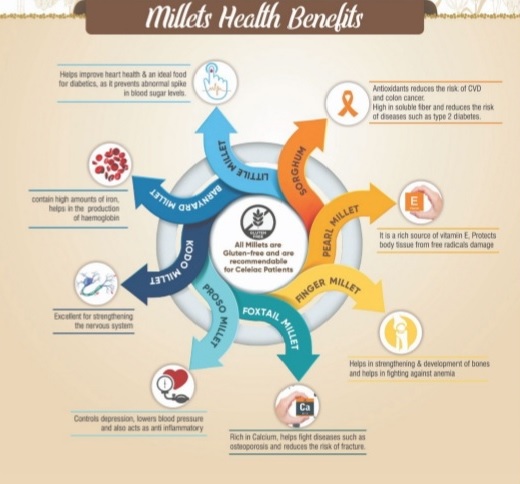Introduction:
Millets have been an integral part of our diet for centuries. In addition to a plethora of health benefits, millets are also good for the environment with low water & input requirement. With the aim to create awareness and increase production & consumption of millets, United Nations, at the behest of the Government of India, declared 2023 the International Year Millets. To commemorate this, the theme for this year’s National Dietetics Day is “MIGHTY MILLETS.”
What are Millets?
Millets are a group of cereal grains that belong to the Poaceae family, commonly known as the grass family.
It is widely consumed in developing countries throughout Africa & Asia.
Millets are divided into 2 categories – large (major) and small millets, with major millets being the most popular or commonly cultivated varieties.
Large millets include:
- Pearl (Bajra)
- Sorghum (Jowar)
- Finger (Ragi)
Minor millets include:
- Foxtail (Kangani or Kakum)
- Proso (Broomcorn/Chena/ Cheno/ Varai)
- Kodo (Kodon)
- Barnyard (Sanwa)
- Browntop (Pala pul/Korale/Andakorra)
- Little millet (Moraiyo/Kutki/Shavan/Sama)
Some other commonly used millets are buckwheat (kuttu), amaranth (rajgira/ramdana/chola), quinoa, oats, etc.
Nutritional Profile & Health Benefits:
While millets may look like a seed, its nutritional profile is similar to that of sorghum (jowar) and other cereals.
Millets are nutritionally superior as their grains contain high amounts of protein, essential amino acids, minerals, and vitamins. Millets are known for their high dietary fiber and hence preferred as dietary foods for people with diabetes and cardiovascular diseases. Millets contain health promoting phenolic compounds which play a vital role in combating multiple lifestyle related diseases.
Millets have gained popularity in the West because they are gluten-free and boasts high-protein, fiber, and antioxidant contents.

Conclusion:
Millets have multiple health benefits and provides our body with the energy it needs to go through the day. Therefore, the key to good health is to include a variety of millets in our daily diet as, every kind of millet has its own health benefits.
Try swapping rice with foxtail millet (also known as Kakum/Kangani) and you will find the difference it will make to your health! It has high iron content and helps in regulating blood sugar levels. Thus, suitable for people with type 2 diabetes.

